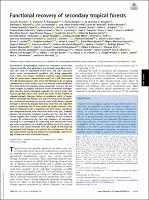Functional recovery of secondary tropical forests

Voir/
Date
11-2021Auteur
Lourens, Poorter
Rozendaal, Danae M. A
Bongers, Frans
Almeida, Jarcilene S
Álvarez, Francisco S
Andrade, Jose Luis
Arreola Villa, Luis Felipe
Becknell, Justin M
Bhaskar, Radika
Boukili, Vanessa
Brancalion, Pedro H. S
César, Ricardo G
Chave, Jerome
Chazdon, Robin L
Dalla Colletta, Gabriel
Craven, Dylan
Jong, Ben H. J. de
Denslow, Julie S.
Dent, Daisy H
DeWalt, Saara J
Dıaz Garcıa, Elisa
Dupuy, Juan Manuel
Durán, Sandra M
Espírito Santo, Mário M
Wilson Fernandes, Geraldo
Finegan, Bryan
Granda Moser, Vanessa
Utrera, Luis P
31 autores más
Sustainable development goals
ODS 13 - Acción por el clima
Type
Artículo
Metadata
Afficher la notice complèteRésumé
One-third of all Neotropical forests are secondary forests that regrow naturally after agricultural use through secondary succession. We need to understand better how and why succession varies across environmental gradients and broad geographic scales. Here, we analyze functional recovery using community data on seven plant characteristics (traits) of 1,016 forest plots from 30 chronosequence sites across the Neotropics. By analyzing communities in terms of their traits, we enhance understanding of the mechanisms of succession, assess ecosystem recovery, and use these insights to propose successful forest restoration strategies. Wet and dry forests diverged markedly for several traits that increase growth rate in wet forests but come at the expense of reduced drought tolerance, delay, or avoidance, which is important in seasonally dry forests. Dry and wet forests showed different successional pathways for several traits. In dry forests, species turnover is driven by drought tolerance traits that are important early in succession and in wet forests by shade tolerance traits that are important later in succession. In both forests, deciduous and compound-leaved trees decreased with forest age, probably because microclimatic conditions became less hot and dry. Our results suggest that climatic water availability drives functional recovery by influencing the start and trajectory of succession, resulting in a convergence of community trait values with forest age when vegetation cover builds up. Within plots, the range in functional trait values increased with age. Based on the observed successional trait changes, we indicate the consequences for carbon and nutrient cycling and propose an ecologically sound strategy to improve forest restoration success.
Keywords
Delegation
Sede Central
ORCID-ID
Fransisco S. Álvarez https://orcid.org/ 0000-0002-4018-775X
Bryan Finegan https://orcid.org/ 0000-0002-7035-255X
Luis P. Utrera https://orcid.org/ 0000-0002-2658-7781
Éditeur
Editorial Board
Is part of
PNAS, Vol. 118 (49)
Status
restrictedAccess
xmlui.dri2xhtml.METS-1.0.item-uri-link
https://doi.org/10.1073/pnas.2003405118

